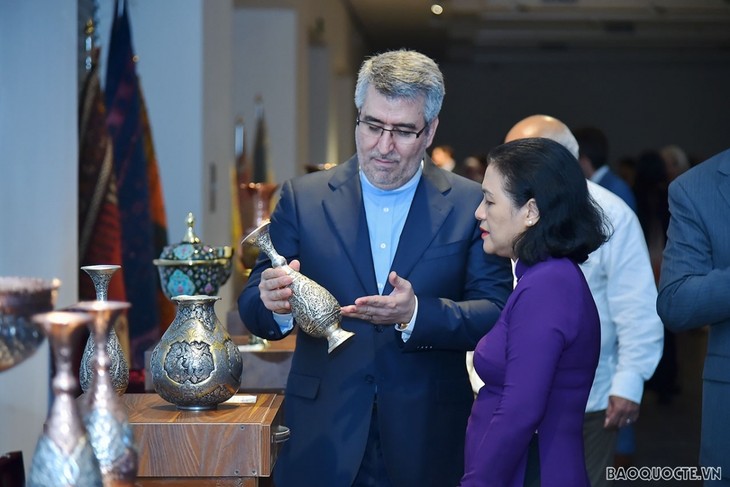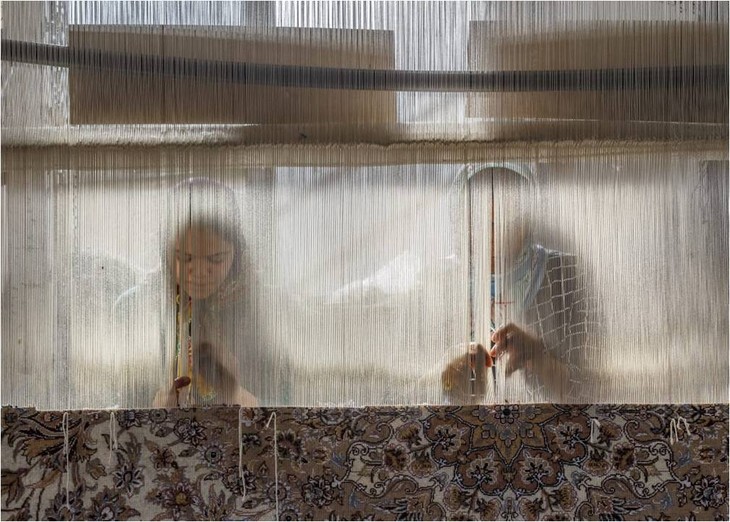 Ambassador Ali Akbar Nazari introduces a handicraft product to exhibition guests. Ambassador Ali Akbar Nazari introduces a handicraft product to exhibition guests.
|
Bao Tram: Welcome Mr. Ambassador to VOV24/7’s Cultural Rendezvous.
Ambassador: Thank you so much for having me here today.
Bao Tram: One of the best ways to discover a nation’s culture is through its art. Tell us what Iran’s art heritages include.
Ambassador: The art of Iran is one of the richest art heritages in the world and encompasses many traditional disciplines, including architecture, painting, literature, music, weaving, pottery, calligraphy, metalworking, and stone masonry.
Bao Tram: What characterizes Iranian art?
Ambassador: To understand the characteristics of Iranian art, you have to know its history. Iran, which was commonly known as Persiauntil the mid-20th century, is home to one of the world's oldest continuous major civilizations, dating back to 7000 BC. As the region of Persia developed, Iranian art gave and received multiple influences from neighboring regions and countries, which impacted the style seen in the artworks. The history of Persia and its art took place in three great phases: the Achaemenid Empire, the Sassanid Empire, and after Islam.
Prior to the Achaemenid Era, Persian culture was in its formative stages of development and Early Persian artwork included intricate ceramics and small bronze objects.
The Achaemenid Era (550-330 BC), begun by Cyrus the Great, was the First Persian Empire. It was primarily influenced by Greek and Egyptian artand architecture, best illustrated by the series of monumental palace complexes built in Persepolis, the capital city of the Achaemenid Empire.
The Second Persian Empire was the Sassanian Era. Sassanian art focused on decorative stone mosaics and dishes typically made of gold and silver that depicted animals and hunting scenes. The most striking Sassanian art from this era, however, were rock sculptures carved into limestone cliffs.
After the end of the Sassanian Era, Persia became part of Islam. While the production of sculpture diminished due to Islamic beliefs, decorative arts including metalwork, weaving, and ceramics continued to thrive. This led to artists focusing on mosaics and ornamentation pieces to adorn mosques and buildings and creating colored roofs out of blue, red, and green ceramic tiles. Drawing was replaced by the popular Islamic art of illumination, which is the decoration of manuscripts and religious texts along with calligraphy. Painting, particularly miniature paintings, was another important form of art within Islamic Persia.
In summary, the historical course of Iranian art reflects the antiquity and variety of artworks, whose evolution is influenced and enriched by different civilizations and cultural traditions. I can say that the quintessential characteristic of Persian art and architecture is its eclectic nature, with influences from Assyria, Roman and Greek empire, ancient Egypt and Islam.
 Fine Persian carpets are exhibited at the event (Photo: baoquocte.vn) Fine Persian carpets are exhibited at the event (Photo: baoquocte.vn)
|
Bao Tram: For many Vietnamese people, the Persian Gulf region, Iran in particular, is associated with carpets and sophisticated handicraft items. What will you tell us about them?
Ambassador: As you all know, the name of Iran and carpet always resonate together and the world oldest carpet named Pazyryk is an Iranian carpet with original Achaemenid motifs. The Iranian carpet is similar to the Persian garden: full of florae, birds, and beasts. The colors are usually made from wild flowers.
Meanwhile, Khatam is an ancient Persian technique of inlaying. It is a version of marquetry where art forms are made by decorating the surface of wooden articles with delicate pieces of wood, bone and metal precisely-cut intricate geometric patterns.
Bao Tram: You’ve mentioned marquetry, one of the most impressive features of Iran’s carpets or vases. Does the marquetry/pattern have any special meaning?
Ambassador: Yes, indeed. Let me share with you some of the most famous patterns:
Garden, tree and plant motifs
These motifs reflects tendency to be greener in life. The mystical relationship of Iranians with water, trees, and flowers is reflected well in garden motif. Among the motifs, tree is of special importance because it is a symbol of life, growth, fertility, and frequent growth.
Animal motifs:
The use of animal patterns in Iranian Art has been common and every pattern has its own meaning. For example:
The goat is a symbol of asking for rain,
The snake is a symbol of health and guardianship,
The fish is the guardian of the tree of life,
The turtle is a symbol of longevity and fertility,
The lion is the symbol of the most powerful force on earth,
The dog is a symbol of war and the defense of the tribe and family,
The peacock is sacred and the bird of paradise,
The eagle is a symbol of power and transcendent power on earth,
The Durna is a symbol of asking for rain and seeking goodness and blessings and rooster is considered a sacred bird in nomads because it sings at dawn and announces the end of night and darkness.
 Carpet weaving in Torud, one of the villages of Shahroud city, Semnan province, Northeastern Iran where there are famous carpet weaving workshops. (Photo: Maryam Abdolhosseini) Carpet weaving in Torud, one of the villages of Shahroud city, Semnan province, Northeastern Iran where there are famous carpet weaving workshops. (Photo: Maryam Abdolhosseini)
|
Bao Tram: How have Iranian handicrafts and other art forms been preserved?
Ambassador: There was an organization in the past, which has become the Cultural Heritage, Tourism and Handicrafts Ministry, which took charge of the protection of ancient Iranian arts. At the same time, we have a very close cooperation with the International Council of Monuments and Sites and art departments at every university and institution of higher education to protect and preserve our art heritages. Holding training courses and forming cooperatives are other ways that art in Iran is protected and passed from one generation to another. Today we have a very advanced technology compared to the past to protect and preserve ancient artworks that require a special atmosphere and special care in regard to humidity, temperature, and light. We now have the knowledge, technology, and resources needed to preserve our precious heritages.
Bao Tram: Thank you so much, Mr. Ambassador, for joining VOV24/7’s Cultural Rendezvous today and sharing with us some interesting facts about Iran’s art heritage.
Ambassador: Thank you so much for inviting us to the interview. It’s my pleasure.